 Stardate 2263.2: Three years into the Enterprise‘s five-year mission, and shortly after barely escaping from a diplomatic mission gone terribly wrong, Captain Kirk is experiencing career ennui, to the point that he’s considering seeking a promotion to Vice Admiral, which would take him off the bridge and put him at a desk. Even a visit to the Federation’s most advanced starbase, Yorktown, doesn’t lift Kirk’s spirits, but the Yorktown’s recovery of an alien refugee in a life pod gets his interest. The Enterprise and her crew set off to help find the alien’s crew, stranded on a planet in an inpenetrable nebula, only to fly into a coordinated ambush. The Enterprise is severely damaged and boarded by legions of aliens, led by Krall, who wants an artifact left over from Kirk’s diplomatic mission gone awry. Kirk orders all hands to abandon ship, but Krall’s allies capture the Enterprise life pods and the crew is taken to a planet within the nebula and held hostage; the Enterprise herself is destroyed. Scott meets a woman named Jaylah, who is unafraid of Krall’s followers but has no wish to take him on personally. Jaylah lives in the wreckage of the U.S.S. Franklin, a missing NX-class ship which apparently crashed on this planet, and Scotty begins working to restore the ship to fighting condition. That suits Kirk just fine, as he intends to free his crew and defeat Krall before the alien can use the artifact to power up a devastating weapon. Krall’s first target: Yorktown.
Stardate 2263.2: Three years into the Enterprise‘s five-year mission, and shortly after barely escaping from a diplomatic mission gone terribly wrong, Captain Kirk is experiencing career ennui, to the point that he’s considering seeking a promotion to Vice Admiral, which would take him off the bridge and put him at a desk. Even a visit to the Federation’s most advanced starbase, Yorktown, doesn’t lift Kirk’s spirits, but the Yorktown’s recovery of an alien refugee in a life pod gets his interest. The Enterprise and her crew set off to help find the alien’s crew, stranded on a planet in an inpenetrable nebula, only to fly into a coordinated ambush. The Enterprise is severely damaged and boarded by legions of aliens, led by Krall, who wants an artifact left over from Kirk’s diplomatic mission gone awry. Kirk orders all hands to abandon ship, but Krall’s allies capture the Enterprise life pods and the crew is taken to a planet within the nebula and held hostage; the Enterprise herself is destroyed. Scott meets a woman named Jaylah, who is unafraid of Krall’s followers but has no wish to take him on personally. Jaylah lives in the wreckage of the U.S.S. Franklin, a missing NX-class ship which apparently crashed on this planet, and Scotty begins working to restore the ship to fighting condition. That suits Kirk just fine, as he intends to free his crew and defeat Krall before the alien can use the artifact to power up a devastating weapon. Krall’s first target: Yorktown.
screenplay by Simon Pegg & Doug Jung
directed by Justin Lin
music by Michael GiacchinoCast: Chris Pine (Captain Kirk), Zachary Quinto (Spock), Karl Urban (Dr. McCoy), Zoe Saldana (Uhura), Simon Pegg (Scotty), John Cho (Sulu), Anton Yelchin (Chekov), Idris Elba (Krall), Sofia Boutella (Jaylah), Joe Taslim (Manas), Lydia Wilson (Kalara), Deep Roy (Keenser), Melissa Roxburgh (Ensign Syl), Anita Brown (Tyvanna), Doug Jung (Ben), Danny Pudi (Fi’Ja), Kim Kold (Zavanko), Fraser Aitcheson (Hider), Matthew MacCaull (Blue Shirt), Emy Aneke (Blue Shirt),
Shohreh Aghdashloo (Commodore Paris), Greg Grunberg (Commander Finnegan), Jennifer Cheon (Control Tower Technician), Jarod Joseph (Control Tower Technician), Jeremy Raymond (Control Tower Technician), Harry Han (Kissing Guy), Gina Brinkman (Kissing Girl), Adam DiMarco (Injured Red Shirt), Fiona Vroom (Orion Girl), Richard Laurence (Chancellor Ambassador), Doug Chapman (Sir Olden), Dan Payne (Wadjet), Anthony Shim (Jin), Andrea Yu (Jeanine), Shea Whigham (Teenaxi Leader), Christian Sloan (Jae), Jake Huang (Krall’s Henchman), Priya Rajaratnam (Night Watch Captain), Luka Hays (Enterprise Crew), Thomas Cadrot (Enterprise Crew), Jennifer W. Evans (Enterprise Crew), Roxanne Fernandes (Enterprise Crew), Jake Foy (Enterprise Crew), Jodi Haynes (Enterprise Crew), Nathan Jean (Enterprise Crew), Tarun Keram (Enterprise Crew), J.P. Mulcaster (Enterprise Crew), Edwin Rodriguez (Enterprise Crew), Alex Rose (Enterprise Crew), Polina Nikolai (Enterprise Crew), Lia Lam (Enterprise Crew), Ian Nsenga (Enterprise Crew), Ashley Edner (Natalia), Sara Maria Forsberg (Kalara Alien voice), Jeff Bezos (Starfleet Official)
Notes: As the extensive “in-universe” notes for this movie may constitute major spoilers, they appear below the review.
LogBook entry and review by Earl Green
Review: Star Trek Beyond is a real beauty, a big-screen installment of what Paramount and CBS now refer to as “the Kelvin timeline” that actually feels like what Star Trek was before. It’s still mired in the conventions of 21st century action blockbusters, sure – the major plot turnarounds in the story all lead up to well-orchestrated hand-to-hand combat/martial arts scenes – but for the first time since this reboot of classic Trek began, we have a movie that lays out the tenets of Roddenberry’s universe, and then subjects its characters to trials and hardships to test their loyalty to those tenets.
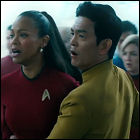 “Our unity is our strength,” Sulu declares while service as the de facto senior officer among an internment camp of Starfleet POWs from the Enterprise, only to have the chief villain, Krall, threaten to kill Sulu unless a much-desired hidden item is handed over by his crewmates. Krall counters with the argument that such unity is a weakness, shortly before Captain Kirk and warrior princess Jaylah show up to kick butt and free the hostages. (For some reason, Jaylay’s albino-pale fighter-in-a-body-stocking look had me thinking “Aurra Sing” the whole time.) Later in the story, Krall is revealed to be a human who has been mutated by repeated abuse of alien life-extension technology (that requires sacrificing another living creature to benefit its user), but more than that, he is a Starfleet war veteran who feels abandoned by his own people. When Krall asks Kirk why he feels Starfleet is worth dying for, Kirk responds, “I’d rather die saving lives than live with taking them.”
“Our unity is our strength,” Sulu declares while service as the de facto senior officer among an internment camp of Starfleet POWs from the Enterprise, only to have the chief villain, Krall, threaten to kill Sulu unless a much-desired hidden item is handed over by his crewmates. Krall counters with the argument that such unity is a weakness, shortly before Captain Kirk and warrior princess Jaylah show up to kick butt and free the hostages. (For some reason, Jaylay’s albino-pale fighter-in-a-body-stocking look had me thinking “Aurra Sing” the whole time.) Later in the story, Krall is revealed to be a human who has been mutated by repeated abuse of alien life-extension technology (that requires sacrificing another living creature to benefit its user), but more than that, he is a Starfleet war veteran who feels abandoned by his own people. When Krall asks Kirk why he feels Starfleet is worth dying for, Kirk responds, “I’d rather die saving lives than live with taking them.”
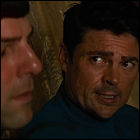 Peppered throughout the rest of the movie are musings on mortality, on duty to one’s culture vs. duty to oneself, and on loyalty and friendship. Sure, it can be argued that, where Star Trek Into Darkness filched wholesale chunks of Star Trek II, Star Trek Beyond is borrowing these plot beats and moments from sources as widely-scattered as The Cage and Star Trek II and III. (I caught myself thinking that there’s something amusing about a bunch of fresh-faced thirty-and-early-forty-somethings ruminating on mortality, until I remembered that one of them recently left us at the age of 27.) Real-life mortality also casts a surprisingly large shadow over the plot as Spock considers retiring from Starfleet to take up the efforts to preserve the culture of Vulcan after learning of the death of “Prime timeline” Spock, played by the later Leonard Nimoy and stranded in the “Kelvin timeline” since it originated in 2009’s Star Trek. I didn’t expect Nimoy’s death to feature so prominently here.
Peppered throughout the rest of the movie are musings on mortality, on duty to one’s culture vs. duty to oneself, and on loyalty and friendship. Sure, it can be argued that, where Star Trek Into Darkness filched wholesale chunks of Star Trek II, Star Trek Beyond is borrowing these plot beats and moments from sources as widely-scattered as The Cage and Star Trek II and III. (I caught myself thinking that there’s something amusing about a bunch of fresh-faced thirty-and-early-forty-somethings ruminating on mortality, until I remembered that one of them recently left us at the age of 27.) Real-life mortality also casts a surprisingly large shadow over the plot as Spock considers retiring from Starfleet to take up the efforts to preserve the culture of Vulcan after learning of the death of “Prime timeline” Spock, played by the later Leonard Nimoy and stranded in the “Kelvin timeline” since it originated in 2009’s Star Trek. I didn’t expect Nimoy’s death to feature so prominently here.
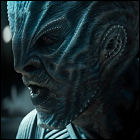 The revelation of the connection between Krall and the presumed-dead human captain of the Franklin is interesting, though I know enough of Idris Elba’s other work to feel like it was a cheat to have him smothered in makeup and acting brutish for most of his screen time. Edison was a far more compelling and fascinating character, and his having turned into a monster – literally – is a bit of a cheat. One of the most fascinating elements of classic Trek is how Roddenberry tried to rewrite the Federation’s DNA in utopian shades, when the actual original series was full of Garths of Izar, Ben Finneys, Captain Meriks, and others – people who had taken the same oath as Kirk and his crew, but somehow justified throwing it all away. Examining Edison in that light from the start would have made for a more compelling character study (and a better use of Idris Elba’s talents).
The revelation of the connection between Krall and the presumed-dead human captain of the Franklin is interesting, though I know enough of Idris Elba’s other work to feel like it was a cheat to have him smothered in makeup and acting brutish for most of his screen time. Edison was a far more compelling and fascinating character, and his having turned into a monster – literally – is a bit of a cheat. One of the most fascinating elements of classic Trek is how Roddenberry tried to rewrite the Federation’s DNA in utopian shades, when the actual original series was full of Garths of Izar, Ben Finneys, Captain Meriks, and others – people who had taken the same oath as Kirk and his crew, but somehow justified throwing it all away. Examining Edison in that light from the start would have made for a more compelling character study (and a better use of Idris Elba’s talents).
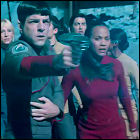 At its heart, the movie, and Kirk’s conflict with Krall/Edison, is about choosing the better angels of our nature rather than listening to the residual, reptilian part of our instincts that instantly fear, reject, and ultimately fight the Other, anything that’s different. And we needed that message right now. Considering the lead time with which a movie has to be written and filmed and produced, it’s amazing how timely Star Trek Beyond is.
At its heart, the movie, and Kirk’s conflict with Krall/Edison, is about choosing the better angels of our nature rather than listening to the residual, reptilian part of our instincts that instantly fear, reject, and ultimately fight the Other, anything that’s different. And we needed that message right now. Considering the lead time with which a movie has to be written and filmed and produced, it’s amazing how timely Star Trek Beyond is.
The cast of the rebooted Star Trek movie franchise has always been the strongest asset of the “Kelvin timeline”, and with expanded roles for McCoy and Scotty (and with McCoy and Spock sharing the kind of “stranded together” subplot that always served Nimoy and Kelley so well on TV), and everyone – 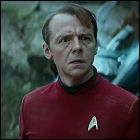 including crewmembers we’ve never seen before – getting their moment, it feels so much more like Star Trek than either of its Abrams-directed predecessors. Justin Lin’s direction is more stylish – in a few scenes, especially fight scenes, perhaps a little too stylized – than Star Trek Into Darkness was. Maybe since he did such a good job taking over for Abrams here, he should try to line up a Star Wars gig too? (And that’s only if he isn’t locked down for the fourth “Kelvin timeline” movie, which would be a welcome development.)
including crewmembers we’ve never seen before – getting their moment, it feels so much more like Star Trek than either of its Abrams-directed predecessors. Justin Lin’s direction is more stylish – in a few scenes, especially fight scenes, perhaps a little too stylized – than Star Trek Into Darkness was. Maybe since he did such a good job taking over for Abrams here, he should try to line up a Star Wars gig too? (And that’s only if he isn’t locked down for the fourth “Kelvin timeline” movie, which would be a welcome development.)
The beauty of Star Trek Beyond isn’t merely that it sees big-screen Trek getting back “on message” for the first time since Star Trek: Insurrection, but that it somehow manages to do so now, at a time when we’ve needed the Roddenberry message hammered home more than 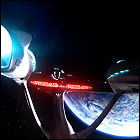 we’ve needed it since 1968. While the real America was embroiled in racial violence, assassinations, culture wars at home, and a war abroad from which we couldn’t seem to extricate ourselves, Captain Kirk and Mr. Spock were on TV every week advocating for a peaceful, cooperative future. Like some sort of mythic heroes who vanish only to return in the hour of greatest need, Kirk and Spock are back in 2016, a summer blockbuster in a summer that has seen the outbreak of open, brazen racial violence, during the run-up to an election in which one candidate not only espouses institutionalized, codified racism, sexism and isolationism, but has seized a major party’s endorsement (therefore revealing that party’s tacit approval of those regressive views). While we’re all counting down to the premiere of Star Trek: Discovery, it should be noted that, in the right-here and the right-now, we desperately needed Star Trek Beyond. We need James T. Kirk, Spock, we need their multiracial crew that’s so post-racism that it never occurs to them that they’re a multiracial crew, and we need the Enterprise – no bloody A, B, C or D – to come dashing to our rescue one more time. And the United States in 2016 is a lot like the Enterprise here: much the worse for wear, literally fragmented, and it falls to us to either be inventive and brave and pull out of the steep dive toward destruction, or to just hang on and plummet into chaos.
we’ve needed it since 1968. While the real America was embroiled in racial violence, assassinations, culture wars at home, and a war abroad from which we couldn’t seem to extricate ourselves, Captain Kirk and Mr. Spock were on TV every week advocating for a peaceful, cooperative future. Like some sort of mythic heroes who vanish only to return in the hour of greatest need, Kirk and Spock are back in 2016, a summer blockbuster in a summer that has seen the outbreak of open, brazen racial violence, during the run-up to an election in which one candidate not only espouses institutionalized, codified racism, sexism and isolationism, but has seized a major party’s endorsement (therefore revealing that party’s tacit approval of those regressive views). While we’re all counting down to the premiere of Star Trek: Discovery, it should be noted that, in the right-here and the right-now, we desperately needed Star Trek Beyond. We need James T. Kirk, Spock, we need their multiracial crew that’s so post-racism that it never occurs to them that they’re a multiracial crew, and we need the Enterprise – no bloody A, B, C or D – to come dashing to our rescue one more time. And the United States in 2016 is a lot like the Enterprise here: much the worse for wear, literally fragmented, and it falls to us to either be inventive and brave and pull out of the steep dive toward destruction, or to just hang on and plummet into chaos.
And it’s easy to slip into the chaos, as an astonishing range of reactions to a Rihanna single associated with the movie proved – members of a fandom claiming to cling to Roddenberry’s IDIC (Infinite Diversity in Infinite Combinations) principle turned out to be harboring a few wispy telltale signs of their own racism, sexism, and fan “gatekeeping” perhaps even more disturbing than the “fake geek girl” debate that preceeded it by a few years. (For the record: the song’s fine, a better James Bond intro song than most of the actual James Bond movies have gotten in recent years.
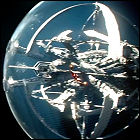 We have a choice ahead of us. A choice much more important and vital and fundamental than which movie or show we’re going to watch.
We have a choice ahead of us. A choice much more important and vital and fundamental than which movie or show we’re going to watch.
If you ever believed for a moment that the Star Trek future can be a real and achievable thing, that we can work now to create that future which isn’t quite utopian but is also a hell of a long way from the dystopia that seems to be the default mode of science fiction anymore, you have a duty. Get off your ass. Boldly go and vote. In 2016 or in whatever year you’re reading this. You can’t build that future without at least laying your own brick.
And then let’s all go watch Star Trek Beyond again, because it’s a good one – the best Star Trek film in quite some time.
Notes: This is the first movie in the “Kelvin timeline” (the official CBS/Paramount designation for the J.J. Abrams reboot movies) not written by Alex Kurtzman and Roberto Orci; it’s also the last movie in that timeline to feature Anton Yelchin as Chekov, as he died within weeks of the movie’s premiere at the age of 27.
Krall’s human alter-ego, Captain Balthazar Edison, is said to have been born prior to the formation of the Federation (which, one assumes, took place immediately after the events depicted in the final episode of Star Trek: Enterprise), but Captain Kirk credits him with victories against the Xindi and the Romulans. This implies that the Franklin, registry number NX-326, is post-NX-01-Enterprise but
pre-Kelvin (NCC-0514; there are hints all the way back to 2009’s Star Trek that Enterprise is the only series whose continuity remains intact in the Kelvin timeline). This implies that a second Xindi conflict took place after the formation of the Federation. However, Scotty also says that the Franklin is the first Starfleet vessel capable of achieving warp four, which would paradoxically make the Franklin older than Archer’s Enterprise, which was capable of warp five from the beginning of that series. Presumably the Franklin remained in service for many years (perhaps receiving an upgrade allowing for faster warp speeds) and was retroactively issued a later registry number, as the fourth season of Enterprise gives us NX-02 (Columbia) and NX-03 (Challenger), indicating that we were seeing the very beginnings of Starfleet. Incidentally, a close examination of the dedication plaque on the Franklin‘s bridge reveals that the ship was actually named for the director’s father, Frank Lin, who introduced him to Star Trek.
Commodore Paris may be an ancestor of Star Trek: Voyager‘s Lt. Tom Paris; he states numerous times that his family has produced several generations of high-ranking Starfleet officers (though it’s worth noting that he’s speaking from the vantage point of the “Prime timeline”). The scenes with Shohreh Aghdashloo as Paris were added in a late round of additional filming. Fiona Vroom appears in a blink-and-you’ll-miss-it, dialogue-free appearance as an Orion woman apparently ending a relationship with a member of the Enterprise’s crew; apparently Orions can join Starfleet in the “Kelvin timeline”, and Fiona Vroom was well qualified to play one, having demonstrated that it’s not easy being green (or a woman) in the Star Trek Continues episode Lolani.
